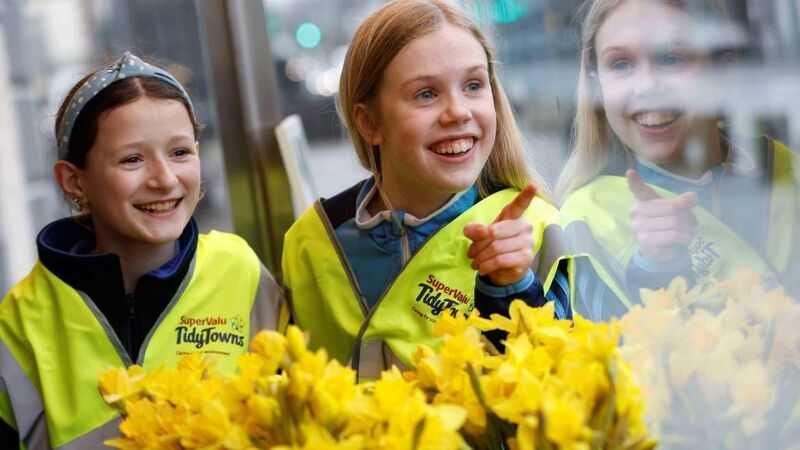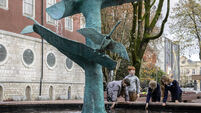10 tips on how to win Tidy Towns contest

Children at the launch of the SuperValu TidyTowns Competition 2024.
The deadline for the 66th annual SuperValu TidyTowns Competition 2024 has passed and that only means one thing - soon teams of judges will be visiting over 1,000 towns and villages across the country to determine the winners of the unique and unparalleled community movement.
The competition began in 1958 and has since become Ireland’s best-known sustainable and environmental initiative. It is administered by the Department of Rural and Community Development and has been proudly sponsored by SuperValu since 1991.
Last year’s contest saw 30,000 volunteers compete with entries received from over 880 towns, villages and communities nationwide.
From demonstrating a clear understanding of nature and sustainability in your local environment to conservation of streetscapes and public places, here are ten top tips from some winning committees on what it takes to clinch the title of Ireland’s Tidiest Town:
1. Community - Your Planning and Involvement
The most effective Tidy Towns groups are the ones with broad representation from across the community involving residents, businesses and public bodies, of all ages and backgrounds. As shown in previous SuperValu TidyTowns competition winning towns, villages and neighbourhoods, the actions of a local group participating in TidyTowns and similar initiatives can greatly improve the sense of community, quality of people’s lives and local environments.
2. A Local Biodiversity Action Plan
Communities should devise a plan specifically for your area that will help your community understand, protect and enhance nature and biodiversity. This may include protected areas and/or areas important for conservation e.g. waterways, field boundaries, coastal features etc.
3. Tree planting and Habitat Creation
All TidyTowns groups are recommended to add to their existing stock of trees by organising tree-planting initiatives with as many residents as possible involved. Projects like hedgerow planting, bee and butterfly banks are easy and inexpensive.
4. Actions for Pollinators
Tidy Towns groups have been at the forefront of efforts to assist our pollinators. Given the importance of pollinating insects in biodiversity, it is expected all groups will undertake projects with these species in mind.
Most local authorities have signed up to the All-Ireland Pollinator Plan so you will likely find a good response when you ask for assistance and advice in this area.
5. Sustainability
This has been evolving in keeping with current EU and government policy as well as ‘best practice’ guidelines.
The sustainability category calls on towns and villages to show an understanding of what this category means and awareness of the move towards a Circular Economy and implementation of Sustainable Development Goals. Here are some top tips for a Sustainable Community:
Shop local: Mention any ‘Shop Local’ campaign as this saves on energy and transport as well as helping the local economy.
Promote ‘no waste’ gift ideas like vouchers/ tickets/memberships.
Sharing resources in the community such as grass-cutting/landscaping equipment.
Lobby for cycle paths and routes (if appropriate) and encourage the local authority to install cycling infrastructure such as secure bike stands and shelters.
6. Tidiness
Judges keep an eye out for general lack of clutter, blocked footpaths, redundant poles, unsightly overhead electric cables, absence of graffiti, and control of weed growth at kerbs. They will assess the absence of litter and dumping, including regular litter patrols, segregation of collected litter during clean-ups and promotion of anti-litter awareness throughout the community.
7. Residential Streets and Housing
Residential streets that include Town Houses are integral parts of towns and villages. Proper presentation and maintenance of all properties and maintenance of frontages, boundary and gable end walls.
Gardens, where applicable, should be presented to a good standard. In housing developments, green areas should be appropriately managed for biodiversity and amenity.
Children’s play areas should also be managed with equipment maintained to best standards.
8. Planning
Streetscape and Public Places - Judges take into account conservation and presentation of heritage buildings and quality of shop-fronts.
Obviously, public spaces such as squares, parks, playgrounds, street scape and their paving, landscaping and street furniture are important and ensuring they are mindful of and access for all.
9. Green spaces
The planning, design and management of green spaces is an important factor in becoming a winning Tidy Town.
The selection and appropriate siting of trees and their ongoing maintenance and attention to the stakes and ties should be a key feature in your local community.
The use of suitable plants for hedges and shrubs for year-round effect is important as is the siting of seasonal planting of pollinator friendly schemes where you wish to highlight important areas.
10. Approach Roads, Streets and Lanes
Committees should consider appropriate presentation of approach roads, including the roadside verges and their boundary treatment.
The appearance of town and village streets, connecting roads, roundabouts within the 60 km/h, laneways, bridges and cycle lanes are all important elements for projecting a TidyTown.







 App?
App?







